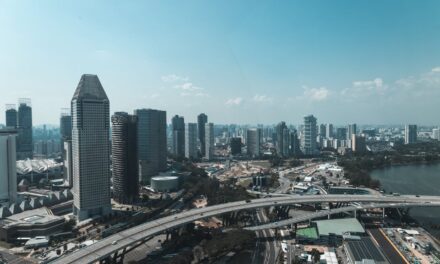With the US and China pushing through some economic turbulence, the ASEAN region is likely to experience some counter-currents in the coming months.
In the US, despite the Federal Reserve keeping its interest rates unchanged on Wednesday, it maintained a hawkish stance going ahead due to sturdy economic data.
“The US consumer remains robust, the labour market is slowly weakening, and the manufacturing sector is full of mixed signals… if we continue to see healthy spending [from US consumers] throughout the summer, the Fed will need to deliver on that dot plot forecast that has pencilled in two [interest rate] hikes,” said Oanda Senior Market Analyst Edward Moya in a note on Friday.
This follows a long and hard-fought battle with inflation over the past year or so. Many market participants were hoping for an end to interest rate hikes before Wednesday’s Fed decision.
Higher interest rates restrict the economy which leads to dampened demand. This should cool the prices of goods & services but will also hurt the economy.
“The latest Fed’s monetary policy guidance is clearly skewed toward a higher level of US interest rates for a longer period [than expected]. Thus ASEAN countries that have a relatively higher level of external debt to GDP are likely to [see] an adverse economic impact such as Malaysia where its external debt is close to 60% of its gross domestic product,” Kelvin Wong, a senior market analyst at Oanda’s Singapore branch, told Diplomatic Network (Asia).
External debt to nominal GDP focuses specifically on the ratio of a country’s external debt to its nominal GDP. External debt refers to the amount of money owed by a country to foreign lenders or creditors, such as other governments, international organizations, or private entities located outside the country.
Singapore has the highest external debt to GDP in the region, with external debt accounting for 386% of the country’s nominal GDP in 2022, according to data company CEIC Data. This fell from a ratio of 433% in the previous year.
Meanwhile, the Philippines’ external debt to nominal GDP ratio in 2022 was 28%; Vietnam’s came in at 38%; Thailand’s was 40%; and Indonesia’s was 30%.
It is also likely that a weaker US economy will hurt Southeast Asian countries with strong trading ties with the US as demand for imported goods will be dampened.
US goods imports from ASEAN totalled USD231.3 billion in 2020, according to the Office of the United States Trade Representative, up 12% from 2019. US imports from ASEAN accounted for 9.9% of overall US imports in 2020.
The top import markets in the region for 2020 were: Vietnam at USD79.6 billion, Malaysia at USD44.1 billion, Thailand at USD37.6 billion, Singapore at USD30.8 billion, and Indonesia at USD20.2 billion.
On the currency front, higher interest rates for longer in the US could heat up the debate for Southeast Asian countries to de-dollarise.
“Given such a bipolar situation, there could be a possibility of a drum-up beat again for the de-dollarisation narrative to take shape within the ASEAN nations as external demand growth got hammered and higher cost of external debt servicing triggered by Fed’s ‘higher for longer’ tight monetary policy stance,” Wong said.
This comes as ASEAN has been pushing for its member states to use their own currencies in transactions with each other.
Just last month, at the 42nd ASEAN Summit, ASEAN members inked an agreement to push for better regional payment connectivity and the use of local currency transactions.
“China may use this opportunity for ‘roadshow trips’ to invite ASEAN nations to join China’s sphere of influence and use the yuan as a trade settlement invoicing currency, and currency swap agreements. If such a scenario unfolds, the US dollar may weaken in the next 6 months,” Wong said.
Turning towards China, the world’s second largest economy is facing a different set of challenges to the US.
China has slowly started opening its liquidity taps following recent weaker-than-expected economic data. This weak data comes after a short spurt of growth in the first quarter of this year after China fully lifted its Covid-19 restrictions in early 2023.
China’s central bank, the People’s Bank of China, cut its seven-day reverse repo rate by 10 basis points to 1.90% from 2.00% on Tuesday.
“[This was] the first cut in ten months after deposit rates of major Chinese state-owned commercial banks were cut last week by 15 basis points and 5 basis points on the three-year and five-year term deposits as per advised by PBoC,” Wong said in separate note.
The seven-day reverse repo rate is set by the central bank to control the amount of money available for lending in the financial system. It represents the rate at which financial institutions can lend funds to the central bank for a week in exchange for collateral, such as government securities or bonds.
When the seven-day reverse repo rate is lowered, it incentivizes financial institutions to seek higher-yielding investments outside of lending to the central bank, potentially increasing the amount of money available for lending in the market and potentially stimulating economic activity.
“[China’s] monetary policy easing stance to boost internal domestic consumption demand is likely to benefit ASEAN countries that have closed trade and capital flows tides with China such as Singapore, explaining the outperformance of Straits Times Index, which gained 0.77%, on Thursday,” Wong told DNA.
In addition to this, a happier Chinese economy would mean more tourists around Southeast Asia which would boost those economies which are more exposed to tourism trends like Thailand and Vietnam.
Though it is worth noting that a cut of 10 basis points is relatively minor, and any positive effects from interest rate cuts would come with a time lag.







